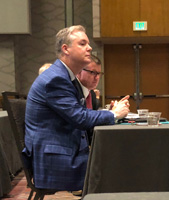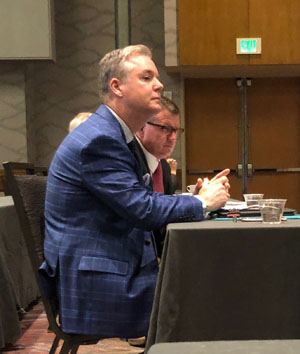
Jim Penrod

VIN News Service photo
AAVSB Executive Director Jim Penrod (foreground) attended the AVMA House of Delegates meeting in July, months into his organization’s efforts to draft veterinary telehealth parameters. The groups have conflicting views about establishing veterinary-client-patient relationships online. Penrod said AVMA officials were present during a recent meeting in Washington, D.C., where AAVSB delegates adopted a telehealth policy and amended practice act. “We consider the AVMA to be a friend, and the leadership of the associations will continue to engage in conversations that impact veterinary regulation,” he said.
A veterinarian-client-patient relationship can develop online, in some instances, without a hands-on physical exam.
That perspective comes from the American Association of Veterinary State Boards, a national organization for state regulators governing veterinary practice. AAVSB delegates gathered Sept. 13-15 in Washington, D.C., for group's annual meeting, where they enacted a revised practice act model that incorporates new guidelines for the appropriate use of telehealth technologies by veterinarians and their clients.
The AAVSB development is the latest in an ongoing debate about whether veterinary medicine should follow human health care, which has embraced telehealth in at least 48 states by eliminating requirements that a physician-patient relationship must be initiated face-to-face.
Nearly as many states expressly forbid the same for veterinary medicine, although changes could be on the horizon. Regulators in several states — Oregon, Florida, Georgia and Utah, to name a few — are said to be considering telemedicine's evolving role in animal health. While authorities in U.S. states wrangle with the concept, online veterinary medicine has taken root in parts of Canada. Last year, the Council of the College of Veterinarians of Ontario approved regulations allowing veterinarians to establish a VCPR remotely, a change intended to improve access to veterinary health care.
AAVSB Executive Director Jim Penrod explained by email the timing and role of his organization's action:
"There are a number of boards that are discussing telehealth," he said. "The AAVSB provided the Practice Act Model with associated Telehealth Guidelines to serve as a timely resource for their discussions."
Those guidelines move the baseline for determining how practitioners know their patients well enough to treat them. The AAVSB stance contradicts widely held views that technology alone cannot be used to develop a VCPR, mainly because animals can't, like a person, explain in words how they're feeling. The concept that veterinarians must first see a patient in practice before providing care remotely is accepted by most state authorities regulating the profession.
VCPR: differing definitions
With its own model practice act, the American Veterinary Medical Association advances that opinion: "We believe that 'traditional standards of care' require a physical examination of a companion animal patient, or familiarity with the animals and site in case of herd health situations, in order to establish the VCPR."
The AVMA telemedicine policy builds on that statement: "Without a VCPR, any advice provided through electronic means should be general and not specific to a patient, diagnosis or treatment."
But the AAVSB and other telehealth proponents believe that perspective cramps the potential for technology to augment access to health care. Rather than a blanket ban on the establishment of VCPRs online, AAVSB's telehealth policy gives veterinarians broad discretion to decide how to establish a VCPR when using remote technology.
"A veterinarian using telemedicine must take appropriate steps to establish the VCPR, obtain informed consent from the client and conduct all necessary patient evaluations consistent with currently acceptable standards of care. Some patient presentations are appropriate for the utilization of telemedicine as a component of, or in lieu of, hands-on medical care, while others are not."
Whether state regulators will buy into that concept is uncertain. Earlier this year, the Oregon Veterinary Medical Examining Board, for example, tabled a proposed new rule that addressed minimum standards for telemedicine:
"Veterinary Telemedicine (VTM) is the delivery of veterinary medical services using information and communication technologies where the veterinarian and the patient are not in the same physical location. Any person practicing VTM in the state must have a valid license to practice issued by the Board. A valid veterinary-client-patient-relationship (VCPR) is required for provisions of VTM."
Under Oregon's VCPR parameters, this means "the veterinarian has seen the animal within the last year (or sooner, if the patient is presented with a new condition) and is personally acquainted with the care of the animal by virtue of a physical examination of the animal or by medically appropriate and timely visits to the premises where the animal is kept."
Asked whether state authorities might consider AAVSB's stance that veterinarians could establish relationships with clients and patients from a distance, OVMEB Executive Director Lori Makinen declined to comment but suggested that the topic could be discussed soon.
"It is likely that the board will propose rules for veterinary telehealth in the near future," she said by email, adding that any proposals would be available on the board's website and published by the Oregon Secretary of State.